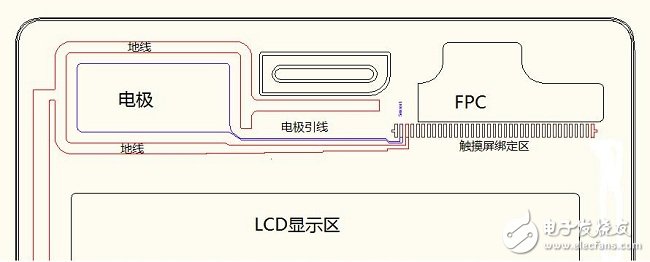introduction Infrared (IR) proximity sensors are currently widely used in smart phones to prevent accidental touches on the touch screen caused by the user's face during calls, while reducing power consumption. IR sensors have the advantages of long detection distance and fast reflection speed, but their expensive cost and complex and demanding assembly requirements have prompted mobile phone manufacturers to seek lower cost and simple structure solutions. The popularity of capacitive proximity sensing in the fields of white goods, smart homes, etc., provides an effective idea for mobile phone proximity sensing solutions. This paper presents a mobile phone proximity sensing scheme based on capacitance changes, and gives the specific system structure, hardware design and control points. This solution has been successfully applied to mobile phone products of well-known brands and has achieved very good results. One system structure The structure of the capacitive proximity sensing system is shown in Figure 1. The controller detects the change in capacitance caused by the object approaching the mobile phone through the electrode. Once the change in capacitance exceeds the threshold set in the controller program, the controller will send an interrupt signal to the mobile phone processor. If the mobile phone is in call mode at this time, The host will turn off the LCD display and touch screen and other components to achieve the purpose of reducing power consumption and avoiding accidental touch. Figure 1 System structure of capacitive proximity sensor The electrode is responsible for detecting changes in capacitance, and its large design quality determines the overall performance of the system. The electrode is essentially a flat conductor, which can be a copper skin on the FPC or an ITO film on the capacitive touch screen. Figure 2 shows an example of the design of an ITO thin-film electrode. The size of the electrode directly affects the detection distance of proximity sensing. When other designs are unchanged, the detection distance increases with the increase of electrode size. The electrode should be as smooth as possible to avoid the right angle or acute angle, and the electrode should be as complete as possible. In mobile phone applications, the electrodes are usually rectangular to maximize the sensing area. At this time, it is necessary to pay attention to the corners of the rounded electrode. The electrode should be placed on the side of the FPC or ITO film close to the touch screen, and the other side of the back usually needs to be vacated. The area of ​​the front case of the mobile phone corresponding to the back of the electrode should avoid a large area of ​​metal, otherwise it will affect the detection distance. A ground wire needs to be laid around the electrode to enhance the capacitance reference, shield noise, and improve the linearity of the sensing direction. The distance between the electrode and the ground wire is recommended to be 0.5mm to 1mm, and the width of the ground wire depends on the specific situation. It is recommended that it is not less than 1mm. The lead from the electrode to the chip should be as short and thin as possible to reduce parasitic capacitance and coupling noise. Figure 2 ITO thin film electrode design Another major factor affecting system performance is the controller. We selected Cypress's programmable CapSense controller CY8C20055 with the new Quitezone technology. Quitezone technology provides unmatched resistance to radiation and conducted noise, and has ultra-low power consumption, which is very suitable for use in mobile terminals such as mobile phones. The technology also achieves the industry's best signal-to-noise ratio (SNR). In high-noise environments, Cypress's patented CapSense Sigma-Delta (CSD) Plus algorithm can also be used to detect capacitance changes as low as 0.1pF. Suitable for proximity sensing. In addition, CY8C20055 uses SmartSense auto-tuning technology, which can dynamically compensate for environmental changes during runtime in real time, thereby ensuring the stability of performance and consistency between channels.
Glass Encapsulated Thermistor
Glass Encapsulated Ntc Thermistor has the capability of operating in the hostile environment of high temperature and humidity because of glass encapsulated framework. With the properties of small size, fast response, high stability and reliability, this type of thermistor can be used in digital equipment, automatic facility, rechargeable battery, temperature compensation of loops of instrument, integrate circuit, quartz crystal oscillator, thermocouple, air conditioner, heating system, Electric Thermometer, Liquid Level Sensor, automotive, electric table-board and more.
Glass Encapsulated Thermistor,Glass Encapsulated Ntc Thermistor,Liquid Level Sensor,Electric Thermometer Feyvan Electronics Technology Co., Ltd. , http://www.fv-cable-assembly.com
